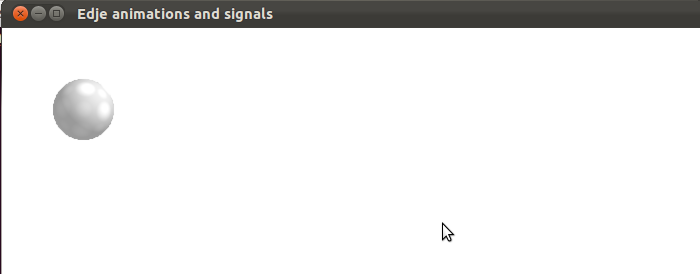In this example we will make use of signals to help to move an image away from the mouse pointer.
Signals are software interruption, this means that when it happens and if the program is sensitive to it the program will stop whatever it is doing and handle the signal.
In this example we are only sensitive to the "mouse,move" signal so we need to register a callback to it. To do this we will add a signal callback to our edje object that will detect "mouse,move" signal coming from the part "part_image" and when this happens we will call the function _on_mouse_over passing the evas pointer as a parameter. The evas pointer is passed as a parameter because we need to know where is the mouse pointer in the screen.
Now, let's pass to the callback function. If we want to keep the ball away from the mouse pointer we need to now where is the ball and where is the mouse and we can easily discovery these things using this:
Now that we have the position of the mouse and the object we just need to set the new location and move the object. To set the new location we do this:
You can change the formula above if you like. Because we are changing the object's position we need to do something if the new position is beyond the canvas size. So here it is:
_on_mouse_over(void *data, Evas_Object *edje_obj,
{
Evas *evas;
int x, y, mouseX, mouseY;
evas = (Evas *) data;
if ((rand() % 2) == 0)
x += ((mouseX - x) + (x / 4 + mouseY / 2));
else
x -= ((mouseX - x) + (x / 4 + mouseY / 2));
if ((rand() % 2) == 0)
y += ((mouseY - y) + (y / 4 + mouseX / 2));
else
y -= ((mouseY - y) + (y / 4 + mouseX / 2));
if (x > WIDTH)
x = WIDTH;
else if (x < 0) x = 0;
if (y > HEIGHT)
y = HEIGHT;
else if (y < 0) y = 0;
printf("Moving object to - (%d,%d)\n", x, y);
}
#define EINA_UNUSED
Used to indicate that a function parameter is purposely unused.
Definition eina_types.h:339
#ifdef HAVE_CONFIG_H
#include "config.h"
#else
#define PACKAGE_EXAMPLES_DIR "."
#define EINA_UNUSED
#endif
#ifndef PACKAGE_DATA_DIR
#define PACKAGE_DATA_DIR "."
#endif
#include <Ecore.h>
#include <stdio.h>
#define WIDTH (700)
#define HEIGHT (700)
static void
{
}
static void
_on_mouse_over(void *data, Evas_Object *edje_obj,
{
Evas *evas;
int x, y, mouseX, mouseY;
evas = (Evas *) data;
if ((rand() % 2) == 0)
x += ((mouseX - x) + (x / 4 + mouseY / 2));
else
x -= ((mouseX - x) + (x / 4 + mouseY / 2));
if ((rand() % 2) == 0)
y += ((mouseY - y) + (y / 4 + mouseX / 2));
else
y -= ((mouseY - y) + (y / 4 + mouseX / 2));
if (x > WIDTH)
x = WIDTH;
else if (x < 0) x = 0;
if (y > HEIGHT)
y = HEIGHT;
else if (y < 0) y = 0;
printf("Moving object to - (%d,%d)\n", x, y);
}
int
{
const char *edje_file = PACKAGE_DATA_DIR"/signalsBubble.edj";
Ecore_Evas *ee;
Evas *evas;
Evas_Object *bg;
Evas_Object *edje_obj;
if (!ee) goto shutdown_edje;
{
fprintf(stderr, "Could not load the edje file - reason:%s\n", errmsg);
goto shutdown_edje;
}
_on_mouse_over, evas);
return EXIT_SUCCESS;
return EXIT_FAILURE;
}
Edje Graphical Design Library.
EAPI int ecore_evas_init(void)
Inits the Ecore_Evas system.
Definition ecore_evas.c:608
EAPI void ecore_evas_title_set(Ecore_Evas *ee, const char *t)
Sets the title of an Ecore_Evas' window.
Definition ecore_evas.c:1541
EAPI void ecore_evas_callback_delete_request_set(Ecore_Evas *ee, Ecore_Evas_Event_Cb func)
Sets a callback for Ecore_Evas delete request events.
Definition ecore_evas.c:1190
EAPI void ecore_evas_show(Ecore_Evas *ee)
Shows an Ecore_Evas' window.
Definition ecore_evas.c:1494
EAPI Evas * ecore_evas_get(const Ecore_Evas *ee)
Gets an Ecore_Evas's Evas.
Definition ecore_evas.c:1314
EAPI Ecore_Evas * ecore_evas_new(const char *engine_name, int x, int y, int w, int h, const char *extra_options)
Creates a new Ecore_Evas based on engine name and common parameters.
Definition ecore_evas.c:1053
EAPI int ecore_evas_shutdown(void)
Shuts down the Ecore_Evas system.
Definition ecore_evas.c:672
EAPI Eina_Bool ecore_evas_object_associate(Ecore_Evas *ee, Evas_Object *obj, Ecore_Evas_Object_Associate_Flags flags)
Associates the given object to this ecore evas.
Definition ecore_evas_util.c:223
EAPI void ecore_evas_free(Ecore_Evas *ee)
Frees an Ecore_Evas.
Definition ecore_evas.c:1097
void ecore_main_loop_quit(void)
Quits the main loop once all the events currently on the queue have been processed.
Definition ecore_main.c:1321
void ecore_main_loop_begin(void)
Runs the application main loop.
Definition ecore_main.c:1311
int edje_shutdown(void)
Shuts down the Edje library.
Definition edje_main.c:262
int edje_init(void)
Initializes the Edje library.
Definition edje_main.c:35
Edje_Load_Error edje_object_load_error_get(const Eo *obj)
Gets the (last) file loading error for a given Edje object.
Definition edje_legacy.c:15
Evas_Object * edje_object_add(Evas *evas)
Instantiates a new Edje object.
Definition edje_smart.c:22
const char * edje_load_error_str(Edje_Load_Error error)
Converts the given Edje file load error code into a string describing it in English.
Definition edje_load.c:108
Eina_Bool edje_object_file_set(Evas_Object *obj, const char *file, const char *group)
Sets the EDJ file (and group within it) to load an Edje object's contents from.
Definition edje_smart.c:467
#define EINA_TRUE
boolean value TRUE (numerical value 1)
Definition eina_types.h:539
EVAS_API void evas_object_show(Evas_Object *eo_obj)
Makes the given Evas object visible.
Definition evas_object_main.c:1814
EVAS_API void evas_object_color_set(Evas_Object *obj, int r, int g, int b, int a)
Sets the general/main color of the given Evas object to the given one.
Definition evas_object_main.c:2024
EVAS_API void evas_object_focus_set(Efl_Canvas_Object *obj, Eina_Bool focus)
Indicates that this object is the keyboard event receiver on its canvas.
Definition efl_canvas_object_eo.legacy.c:39
EVAS_API void evas_object_resize(Evas_Object *obj, Evas_Coord w, Evas_Coord h)
Changes the size of the given Evas object.
Definition evas_object_main.c:1236
EVAS_API Evas_Object * evas_object_rectangle_add(Evas *e)
Adds a rectangle to the given evas.
Definition evas_object_rectangle.c:78
